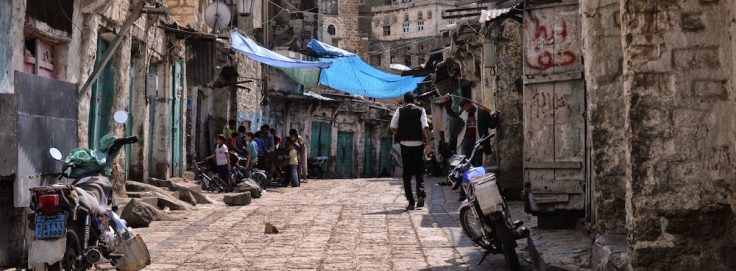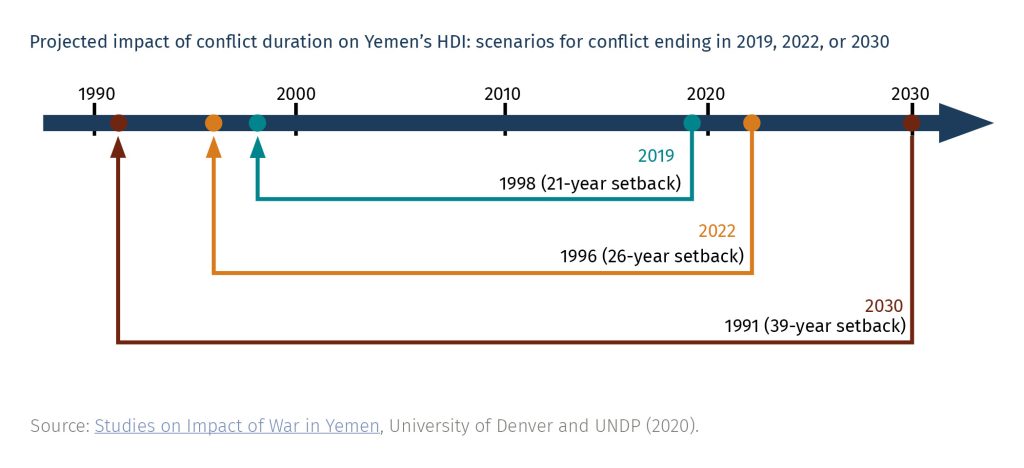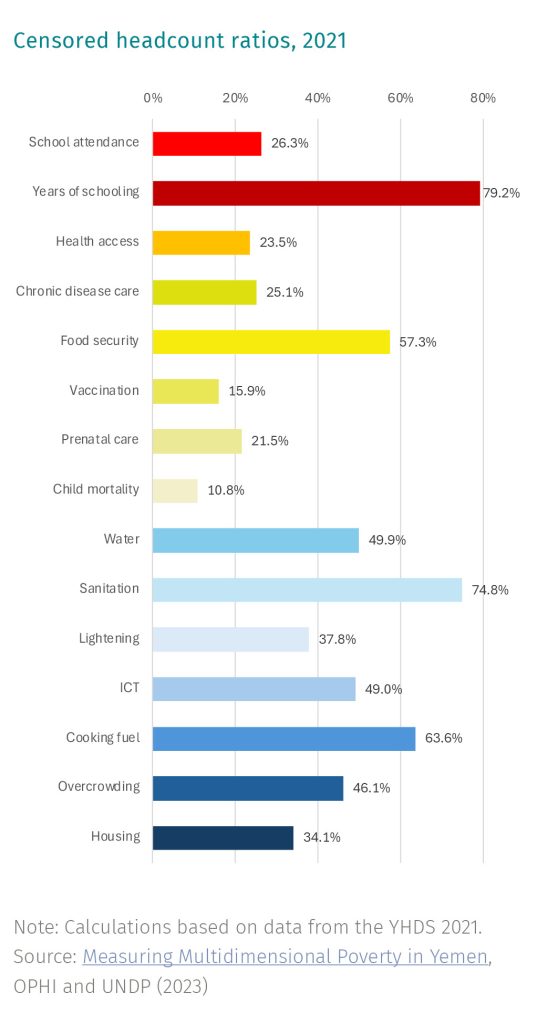
Search
A Roadmap to Recovery: Addressing poverty in Yemen’s ongoing conflict

Prior to the escalation of armed conflict in 2015, development in Yemen was strained. As a country of 30 million people, it ranked 153rd on the Human Development Index (HDI), 138th in extreme poverty, 147th in life expectancy, 172nd in educational attainment, and was in the World Bank low-middle income category. Yemen did not achieve any of the Millennium Development Goals and it is likely that it will not achieve any of the Sustainable Development Goals (SDGs) by 2030 due to the adverse impact of the ongoing crisis.
The ongoing conflict has further reduced the pace of development and exacerbated poverty and hunger. The impacts of conflict in Yemen are devastating – nearly 250,000 people have been killed directly by fighting and indirectly through lack of access to food, health services, and infrastructure. Of the dead, 60% are children under the age of 5. The long-term impacts of conflict are both vast and devastating, placing it among the most destructive conflicts since the end of the Cold War. The conflict has already set back human development by more than 20 years, as measured by the HDI.
Most of Yemen’s population is poor. UNDP and OPHI’s report on measuring multidimensional poverty in Yemen indicates that 82.7% of the population live in multidimensional poverty in Yemen. That is, more than eight in every ten people in the country (in the regions the surveys were collected) were living in multidimensional poverty. The intensity of poverty, or the average number of deprivations faced by multidimensionally poor people, is 46.7%. This means that, on average, a poor person experienced more than 45% of the possible weighted deprivations. The indicators showing the highest levels of deprivations are years of schooling and sanitation, with more than 70% of the poor population deprived in these indicators.
The national Multidimensional Poverty Index (MPI) used in this study is based on the Yemen Human Development Survey (YHDS) 2021, and is composed of six dimensions: education, health, child and maternal health, services, living standards, and employment. The national MPI includes dimensions and indicators that capture deprivations for individuals and households. The indicators are computed at the household level, assuming that all household members share achievements and deprivations equally. Statistical tests were performed to validate the measure’s robustness and significance at the national level and for governorates.
The YHDS included a sample of 1,681 households. It was the first face-to-face, representative household survey collected since the onset of conflict. It aims to provide a detailed overview of welfare, food security and human development indicators in Yemen, enabling intra-household analysis. Data were collected between April and September 2021, including information on education, health, employment status, and living conditions in the Internationally Recognized Government (IRG) (or Southern Yemen). The survey provides regionally representative data in Al Bayda, Ta’iz, Hadramawt, Shabwah, Aden, Lahj, Ma’rib, Al Maharah, and Ad Dali’ governorates.
“82.7% of the population live in multidimensional poverty in Yemen.”
The national MPI, which is the product of the incidence (percentage of people living in multidimensional poverty) and intensity (average number of deprivations faced by poor people) of multidimensional poverty, was 0.386. Therefore, multidimensionally poor people faced on average 38.6% of all possible deprivations in Yemen, if all individuals were multidimensionally poor and deprived in all indicators.
Poverty tended to be higher in rural areas (89.4% of the population) than urban areas (68.9%). Ad Dali’ and Al Bayda had the highest incidence of multidimensional poverty. Given the large population in the Ta’iz governorate, it is estimated that 40% of multidimensionally poor people live in this region. Nationally, years of schooling and sanitation are the two indicators with the largest censored headcount ratios (the percentage of people who are multidimensionally poor and deprived in each indicator), with more than 70% of multidimensionally poor people being deprived in these indicators. Of the 17 indicators measured, years of schooling (79.2%), followed by sanitation (74.8%) and cooking fuel (63.3%), have the highest percentage contribution to the national MPI and therefore to national poverty.
In addition, female-headed households have a lower incidence of multidimensional poverty than male-headed households. However, these differences are not significant.
In terms of the marital status of the household, the results reveal that households where the head is divorced have a lower incidence of multidimensional poverty compared to other households. By contrast, households whose head is married with more than one wife have higher levels of people living in multidimensional poverty, and the intensity of their poverty is higher.
In addition, the incidence of poverty of people living in smaller households is 64.4%, compared to 86.4% and 91.1% for people living in households with five to nine members or more than nine members, respectively.
Finally, the results reveal that households with members with disabilities have higher levels of multidimensional poverty than households without members with disabilities (86.4% versus 81.2%).
Conclusion and Recommendations
The internal conflict of Yemen has had a negative impact on the living standards of individuals and households in the country. This analysis has revealed that the country faces high levels of poverty and deprivation, and that there are several challenges to guaranteeing access to basic services and opportunities.
Deprivations in years of schooling and sanitation are two of the highest deprivations, with more than 70% of the population deprived in these indicators.
In addition, there are important differences between rural and urban areas and between governorates. This reflects that some areas are more affected by the ongoing conflict than others, and that there are areas where people face higher barriers to access services, or where services are not available.
The national MPI report recommends putting in place a poverty reduction strategy that addresses the issues of inadequate access to basic services and enhances economic opportunities.
This article was published in Dimensions 17

















